![10 Analytics Dashboard Examples to Gain Data Insights for SaaS [+Best Tools]](https://blog-static.userpilot.com/blog/wp-content/uploads/2024/03/10-Analytics-Dashboard-Examples-to-Gain-Data-Insights-for-SaaS-Best-Tools.png)
We get it. “Data-driven decisions” is the mantra of the modern business. But with data gushing from every app, platform, and spreadsheet, it’s easy to end up drowning in numbers instead of swimming in insights.
The solution? A well-built analytics dashboard. But not just any dashboard. You need one that’s tailored to your business, easy to use, and packed with actionable insights.
If you’re looking for inspiration, here are 11 analytics dashboard examples to help you build your own.
What’s the biggest issue with your current analytics dashboards?
Try Userpilot Now
See Why 1,000+ Teams Choose Userpilot

What makes a great analytics dashboard?
Too often, dashboards fall into the trap of data overload, “feel-good” key metrics yet vanity, static display. To make your dashboards work, here are a few things to consider:
- Clear: A dashboard should be designed to clearly deliver the right information to its target audience and display changes and trends in data over time.
- One-click away: The most important data should be prioritized and immediately accessible, ideally just one click away, so users can quickly get the information they need.
- Intuitive: It should also be intuitive, with a user-friendly interface that can be easily understood by different viewer personas.
- Customizable: Dashboards should be customizable so that they can present data or key metrics across different time periods or for different customer segments.
11 Analytics dashboard examples for SaaS
Dashboards are built for different aspects of your business, such as feature usage, customer journey, and digital marketing. Therefore, you need to keep different dashboards for different types of analytics.
Here are 11 analytics dashboard examples.
1. Web analytics dashboard
Web analytics dashboards use data generated by customers visiting and interacting with your website. The web analytics dashboard showcases important metrics such as website traffic sources, sessions, bounce rates, devices, unique pageviews, new visitors, and returning visitors.
Web analytics enables you to understand your website’s visitors and use the insights to improve customer experience. It also helps you optimize your content marketing efforts and SEO strategy.
For instance, you might find that your most popular traffic source is organic traffic, while the least effective one is paid channels. Consequently, you would have to invest more resources in your organic strategy.
Google Analytics dashboards give you all-encompassing insights into website activities. By simply logging into your Google Analytics account, you can create reports about your acquisition channels, conversion rates, and engagement levels.
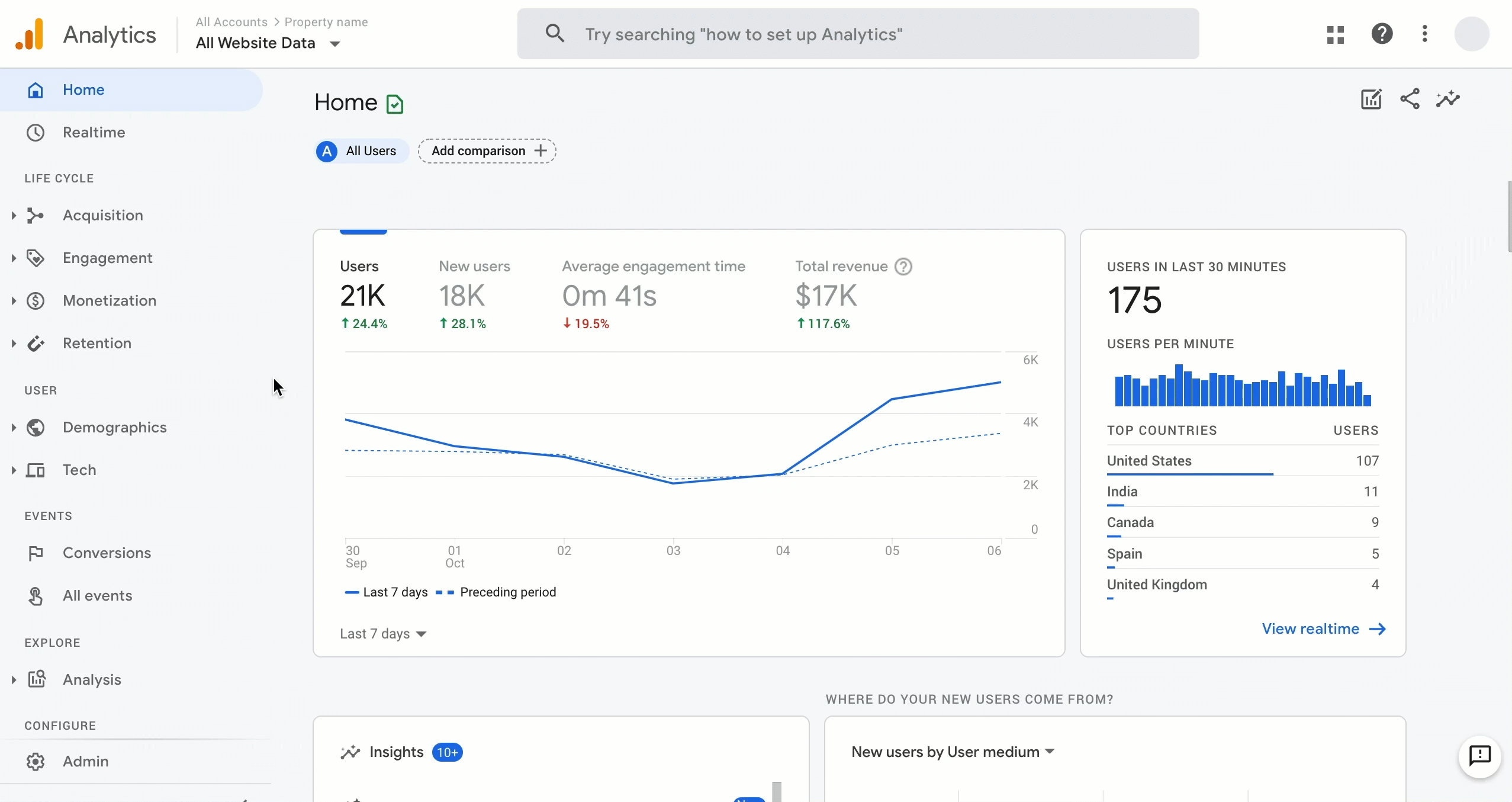
2. Digital marketing dashboard
While web analytics offers rich insights into the performance of your site, digital marketing analytics is much more specific.
A digital marketing dashboard provides a thorough understanding of the impact of your marketing strategy on metrics like conversion rates and digital engagement. It precisely tells you where and how to improve your marketing efforts.
For example, you can use digital marketing analytics to track how individual leads and prospects interact with your digital channels over time. Did an individual find your website via Facebook? Are they converting for paid ads posted on Facebook? Such insights guide your future marketing strategies.
Moreover, digital marketing analytics allows you to gauge the relationship between marketing channels. You can track essential metrics across all digital channels, like blogging and email marketing, and check how multiple channels perform together.
The diagram below shows that although the company spends only $1,000 more on Facebook than Google, the cost per conversion for Facebook is far higher.
On the other hand, Google Ads results in the highest number of conversions. This suggests that the company should shift resources from Facebook to Google Ads to be efficient.
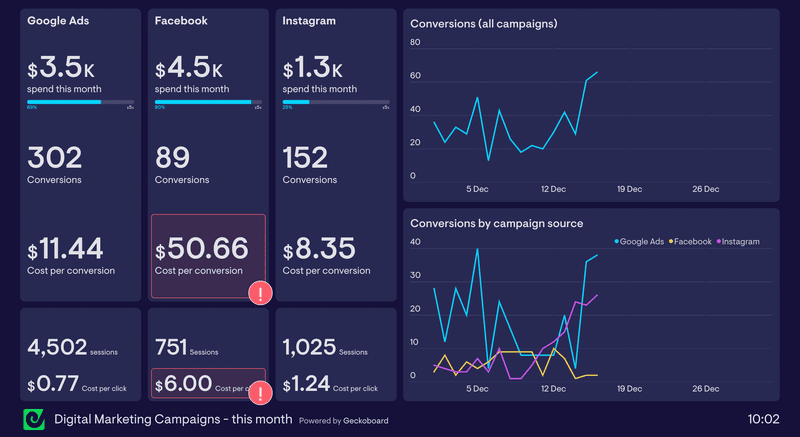
3. Business insight analytics dashboard
On the one hand, you can perform web analytics or user behavior analytics to get specific insights. On the other, you can gather insights based on your overall business goals.
Business insight analytics uses key datasets based on business objectives to improve business decisions. As a SaaS product growth manager, your job is to choose the KPIs that define the success of your business and build dashboards accordingly.
Most companies use databases to organize and store big datasets. Analyzing these data provides information on a wide range of business topics. With the right reporting, you can share dashboards to establish cross-team transparency and alignment with business goals.
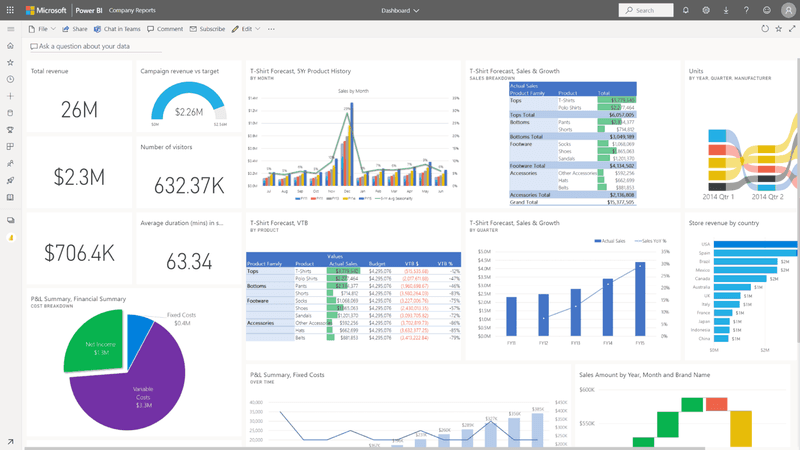
4. Social media dashboard
Social media analytics involves collecting and analyzing data based on KPIs from one or several social media accounts. Some core social media metrics include the number of impressions, page reach, audience, post link clicks, etc.
The social media dashboard enables you to gain a deeper understanding of your social media audience. The dashboard helps you:
- Know which account is most used by your audience.
- Identify the kind of social content that gets you the highest reach and resonates the most with your audience. You can also find out the platforms on which this type of content is the most popular.
- Evaluate the performance of your social media marketing campaign.
- Discover the account that has the highest engagement level or conversion rates.
- Get actionable insights to further strengthen your social media strategy to meet specific business goals.
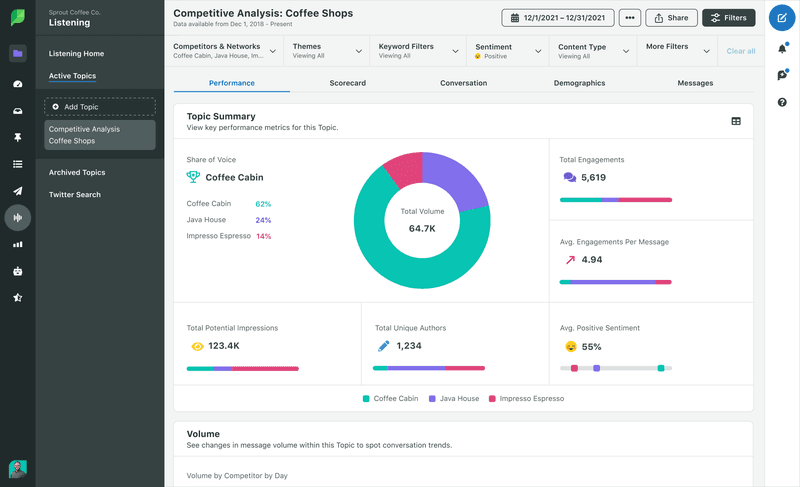
5. Trial to paid conversion dashboard
Your free trial is the gateway to paid subscriptions. It’s where users get to experience the value of your product firsthand. But how do you ensure they don’t just walk through the gate and then wander off?
The trial-to-paid conversion dashboard helps you track the effectiveness of your free trial and identify any leaks in your conversion funnel. It’s like having a map that shows you exactly where users are getting lost on their journey to becoming paying customers.
Take Userpilot’s trial to paid conversion dashboard as an example. You monitor metrics such as conversion rates, trends, time to convert, etc.
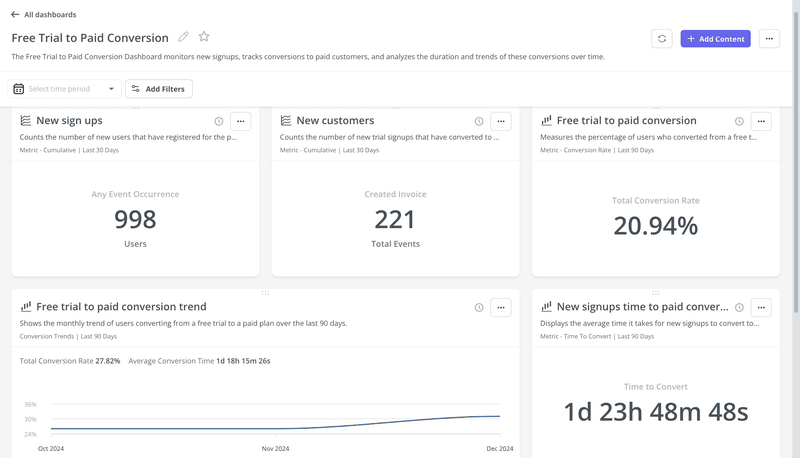
6. Product usage analytics dashboard
In-app product usage analytics lets you see how and when customers are using your product. It helps you make data-driven decisions to boost engagement, increase conversion, and reduce churn. But how does that happen?
By tracking important metrics across several customer segments, you can determine what aspects of your product are the most appealing to each segment.
Userpilot’s product usage analytics dashboard can also highlight data on user interactions during specific time periods. This will enable you to personalize the customer experience and improve engagement.
This data analytics dashboard can also signal potential churn with user stickiness and retention analysis.
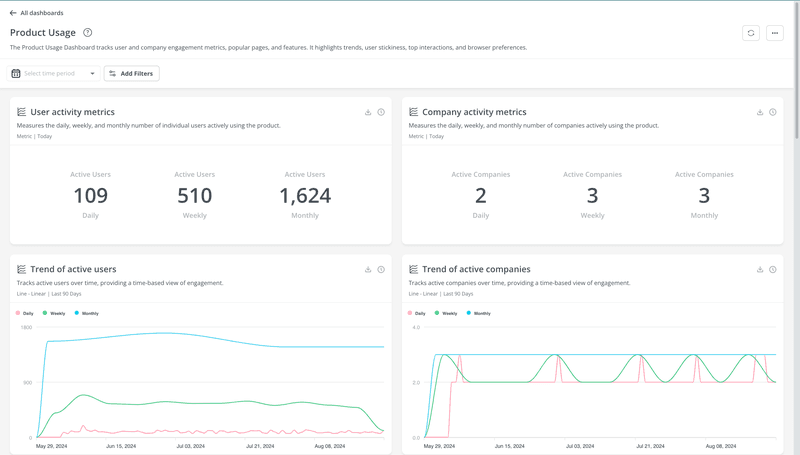
7. User journey analytics dashboard
Track customers across all stages of the customer journey to reflect on and enhance the customer experience.
Here you collect data on each individual user and track metrics like the average length of a user session or how often the customer uses a particular feature in a month.
You can leverage data from the user journey analytics dashboard to map out the path a user takes from signing up to becoming an active customer who also refers your product to others.
This user journey mapping focuses on user interactions with your product. It helps you discover the friction and drop-off points that prevent users from moving forward to the next stage.
You can use customer journey analytics for several user segment categories like onboarding, engagement, marketing, and revenue.
Below is the user activation dashboard from Userpilot that shows important metrics and reports that reflect user behavior during the activation stage.
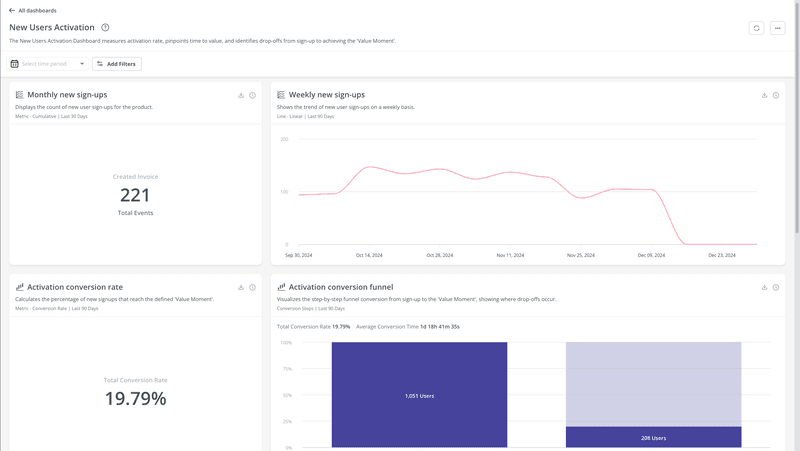
8. User behavior analytics dashboard
Customer behavior analytics tells you what customers are doing on your app, learn why they do it, and how you can use data to improve their experience.
The dashboard provides valuable information on user behavior that you can use to segment customers. Identify patterns that either lead to customer success or failure.
For example, you can follow the happy paths taken by power users to identify your strengths and capitalize on them to increase customer success.
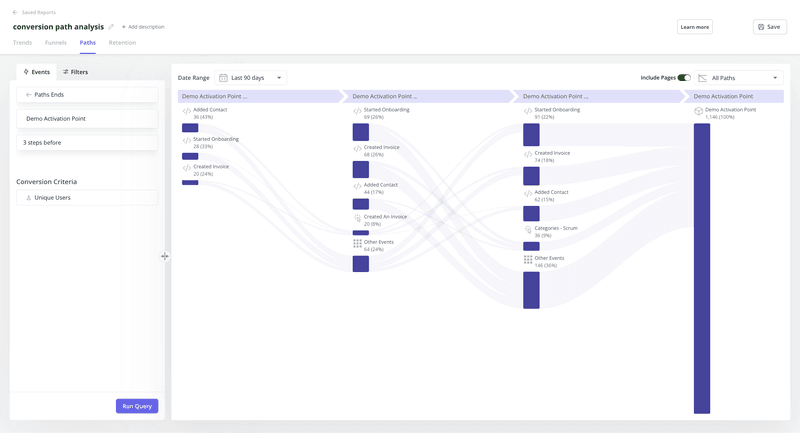
Moreover, behavioral analytics offers insights into every user’s milestones in their journey. You can also measure the adoption rate of new features and use onboarding elements like tooltips to drive user engagement if needed.
9. User retention dashboard
Such data analytics dashboards show trends and metrics related to retaining customers. This dashboard helps SaaS companies analyze trends, identify issues, and make informed decisions to improve customer retention strategies.
The user retention dashboard from Userpilot shows retention rates and trends for different user segments and for different time periods (daily, weekly, and monthly). You can further filter this information for granular insights.
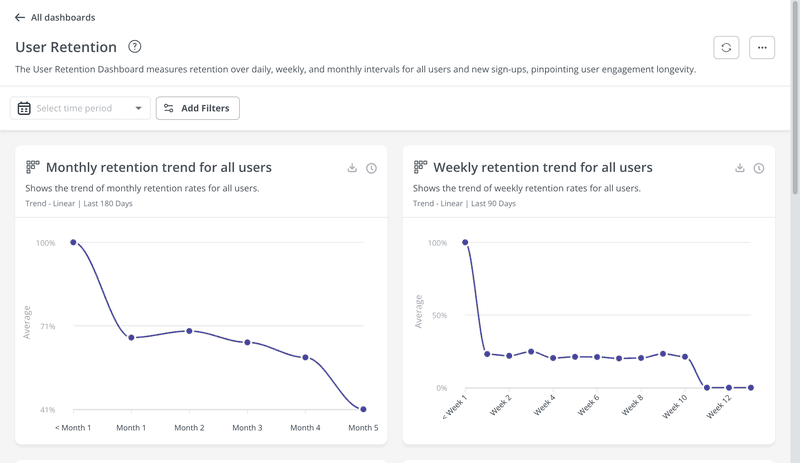
10. Knowledge base engagement dashboard
SaaS companies often use self-service support, such as an in-app knowledge base, to prevent frustration among customers.
The knowledge base engagement dashboard lets you track the real-time performance of self-serve content and see what can be improved or updated.
It lets you know how customers engage with your knowledge base content. You should cross-reference the data with support tickets to see what content is helpful and what is not.
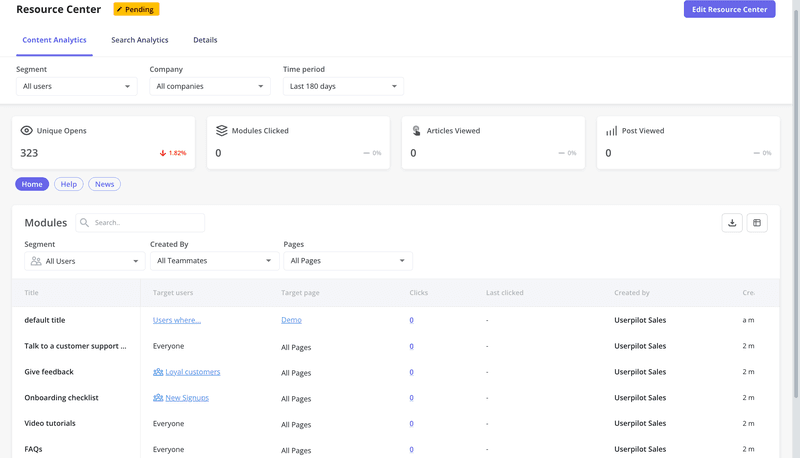
11. Net Promoter Score analytics dashboard
The NPS dashboard shows your NPS score and the percentages of promoters, passives, and detractors. It also displays user sentiment analysis charts, trend charts, and distribution charts.
In-app NPS surveys are used to collect user sentiment data by asking users about their likelihood of recommending your product to others on a scale from 1 to 10. Detractors give a score of 6 or below and are the most likely to churn. On the flip side, promoters are your power users who rate you 9 or 10.
By observing trends in NPS scores over time, you can check the impact of churn reduction strategies on the percentage of detractors. It’s also possible to use loyalty programs and personalization to convert detractors and passives to promoters.
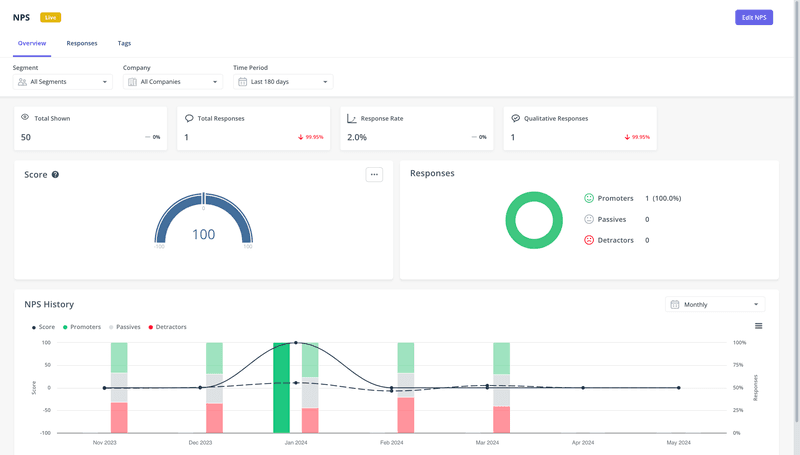
Conclusion
Now that you’ve gone through the analytics dashboard examples, you can start focusing on the different types of product analytics and improve your product growth efforts.
Want to build custom dashboards for your business? Book a Userpilot demo and get started!
Best tools to create insightful analytics dashboards
Analytics tools are a time and cost-saving means of tracking and visualizing data in dashboards. They make any analysis process much easier to perform and interpret.
Here are 5 analytics platforms for creating dashboards.
1. Userpilot for actionable in-product analytics
Userpilot is a product growth tool that offers product analytics, user engagement, and customer feedback functionalities.
It also offers a number of dashboards to help you visualize key metrics. We’ve already touched upon its predesigned dashboards, but what makes Userpilot truly stand out is its custom dashboard feature.
You can create dashboards from scratch or start from a template – free trial to paid conversion, feature engagement, or expansion revenue & upgrades.
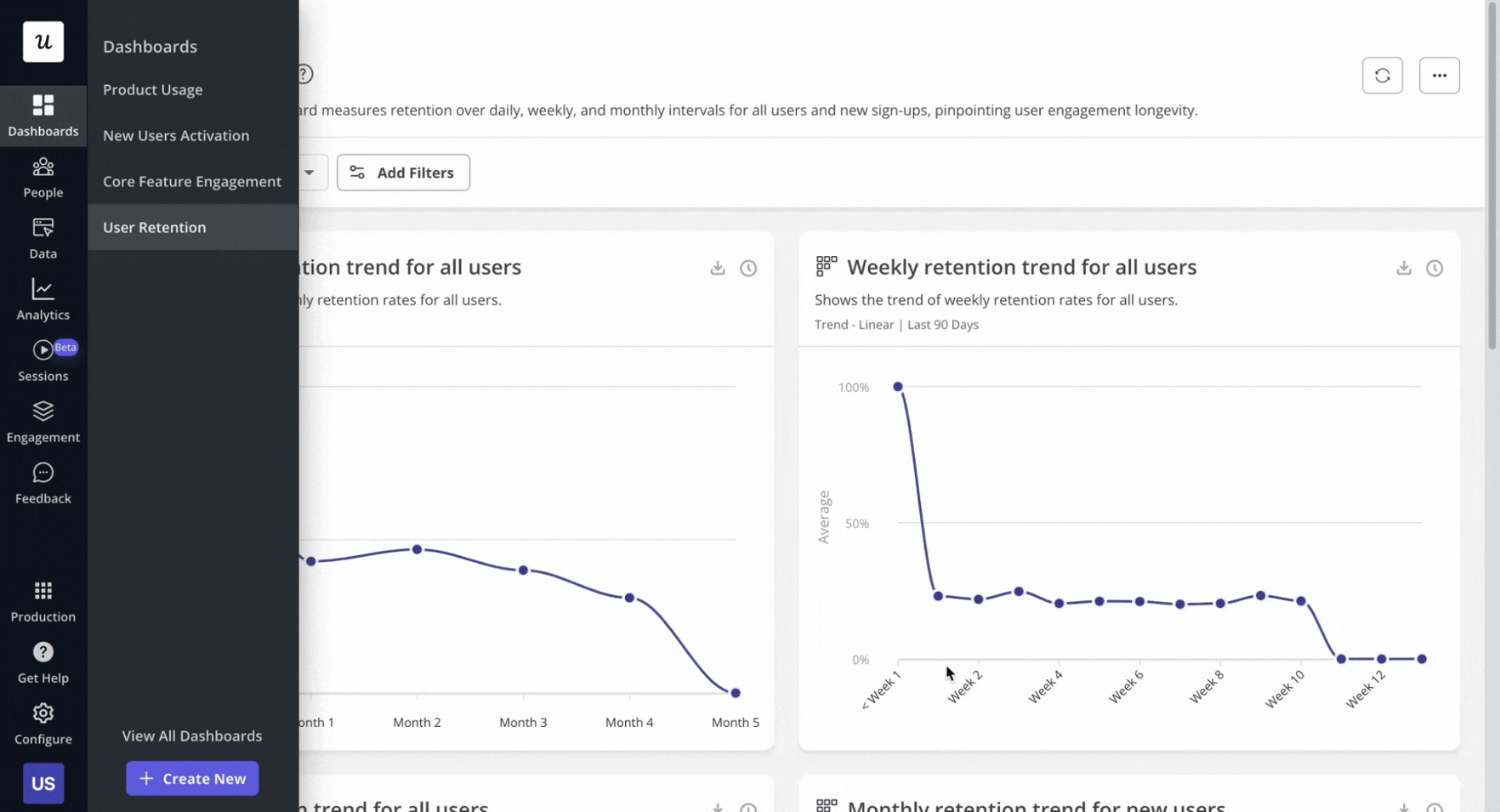
Let’s say you go for the free trial to paid conversion template. All you need to do is select the ‘sign up event’ and ‘trial conversion event’ and then click on ‘create dashboard.’
In a matter of seconds, you’ll witness an intuitive analytics dashboard showing important metrics, like free trial to paid conversion rate, new sign-ups, etc. You can also easily share these dashboards with other team members for smoother collaboration.
Userpilot’s analytics capabilities aren’t limited to just data visualization dashboards. Here’s a sneak peek of what Userpilot has to offer:
- Analytics reports (funnel, retention, path, and trend analyses).
- Advanced user segmentation.
- Feature tagging and custom event creation.
- Resource center analytics.
- Survey analytics (including NPS dashboard).
- Session recordings
2. Amplitude for customer behavior analytics
Amplitude analytics lets you use any combination of behaviors, products, and user profiles to create a highly targeted customer data dashboard.
The platform also lets you observe behavioral patterns such as conversion drives and paths taken by customers in their journey.
Amplitude lets you analyze user behavior according to specific events and event properties. You can use the cohort analytics dashboard for a more in-depth analysis of user interactions.
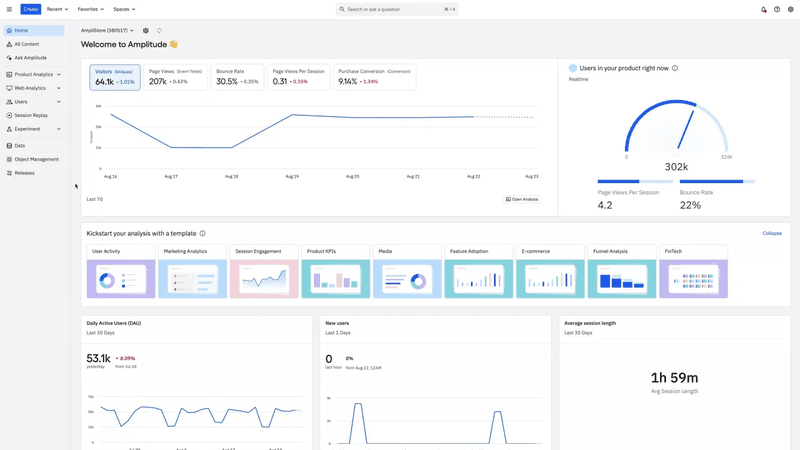
3. Mixpanel for advanced customer journey analytics
Mixpanel is a powerful tool for customer journey analytics.
Its Flows analytics lets you track user paths and drop-off points. Analyzing drop-offs helps you know why users leave before completing a desired action and make improvements to reduce friction.
Mixpanel’s Impact analysis is used to determine the impact of new features. The A/B testing feature helps you find variants with the greatest positive effect on engagement and retention.
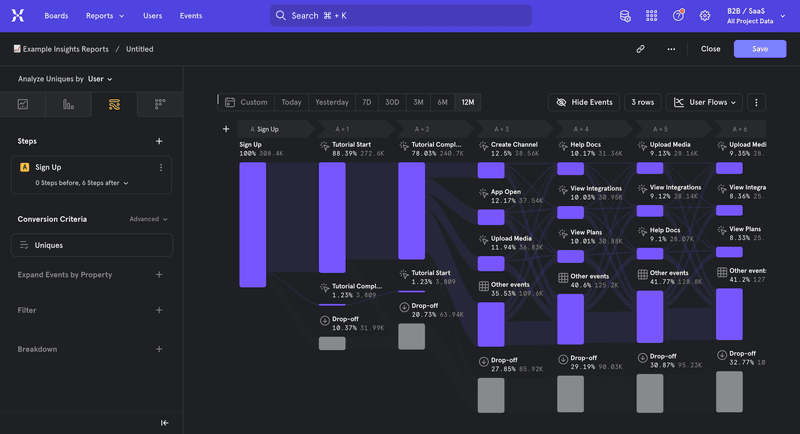
4. Google Analytics for overall web analytics
As you connect your website and your Google Analytics account, you can assess how customers from specific marketing campaigns interact with your product experiences.
Google Analytics is also useful for learning how different acquisition channels impact customer interactions.
However, tracking general Google Analytics data like where users go and how long they stay there can make you lose sight of actionable insights like how visitors use your website.
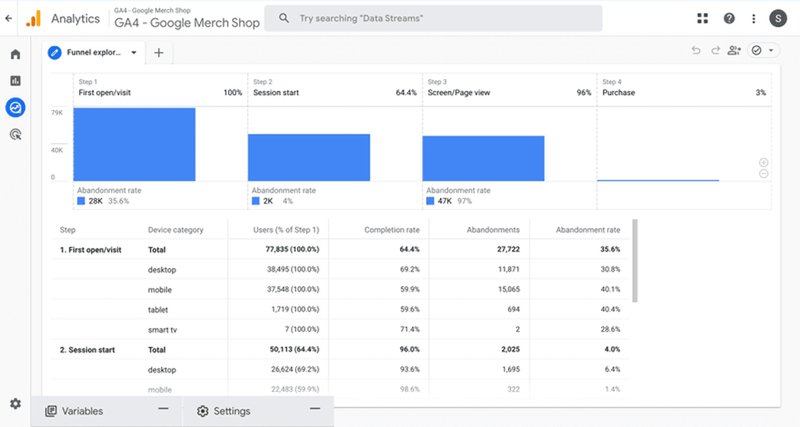
5. PowerBI for business intelligence analytics
If you want to gather business intelligence insights, PowerBI lets you connect, combine, and analyze your whole database to monitor core business metrics.
You can easily connect data models, Excel queries, and reports to the platform’s dashboards and visualize data for effective analysis.

Analytics dashboard examples FAQs
What is an analytics dashboard?
An analytics dashboard is a visualization tool that organizes key performance indicators. This makes it convenient for business teams to evaluate and interpret the results of any kind of analytics.
Moreover, you can share the dashboard with others in your organization to encourage cross-team collaboration.
Dashboards also allow you to track data changes quickly and, thus, make informed decisions based on real-time data.
How do you make an analytical dashboard?
Creating an analytical dashboard involves a systematic process that includes the following steps:
- Define your goals: What do you want to achieve with this dashboard?
- Choose KPIs: What metrics will help you track progress toward your goals?
- Gather data: Collect the necessary data from your sources (i.e., your data warehouse, analytics tools, etc.).
- Select a tool for data visualization: Choose a dashboarding tool (e.g., Google Data Studio, Tableau, Power BI) to create charts and graphs for KPIs display.
- Add interactivity: Allow users to filter, drill down, and explore the data.
- Share and iterate: Publish your dashboard and continue to improve it based on feedback.
What is the best analytics dashboard?
There’s no one-size-fits-all “best” analytics dashboard. It truly depends on your specific needs and objectives. For example, a Google Analytics data dashboard might be helpful enough for marketing teams, while for product teams, it means nothing.
Beyond just the metrics, the ideal dashboard should also consider:
- Your audience: Who will be using this dashboard and what is their level of data literacy? A dashboard for executives might focus on high-level summaries, while one for analysts might allow for deeper exploration.
- The platform: Different tools offer varying levels of customization, visualization options, and integration capabilities. Choose one that aligns with your technical skills and budget.
- Data accessibility: Ensure your chosen tool can easily connect to the data sources where your key metrics reside.







